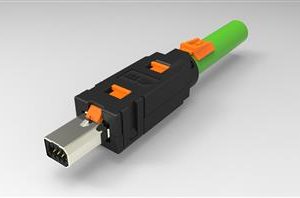 The cost, complexity and scalability challenges of Ethernet-based communications mean that serial interfaces are still the standard for wired communications. This is understandable, given the cost-effectiveness and reliability of IO-Link and RS-485. Design and software engineers are also familiar with these standards.
The cost, complexity and scalability challenges of Ethernet-based communications mean that serial interfaces are still the standard for wired communications. This is understandable, given the cost-effectiveness and reliability of IO-Link and RS-485. Design and software engineers are also familiar with these standards.
New embedded processor technologies are helping to accelerate the shift to Ethernet by integrating MAC support as well as support for various industrial Ethernet protocols such as EtherCat and Profinet.
Ethernet for industrial communications
Meeting the demands for increased efficiency and flexibility in modern manufacturing processes requires using communication protocols that can handle the rapidly growing bandwidth of connected systems.
With more sensors and higher-level processing capabilities, such as edge AI, the systems in these settings need to reliably and quickly transmit more and more data. This is where Ethernet is advantageous and provides a mechanism for transferring latency-critical data – especially for time-sensitive networking and protocols such as EtherCat and Profinet.
“We’re in the middle of a transformational journey to Industry 4.0, where more factories are adopting Ethernet to meet the high-bandwidth demands of modern systems and take advantage of more data-driven decision-making,” says Alex Weiler, general manager, factory automation and control at Texas Instruments. “Ethernet enhances the real-time capabilities of factory and process automation, allowing for next-generation manufacturing to incorporate more machine learning, predictive analytics and autonomous robotics.”
The transition to Ethernet
In industrial communication designs embedded processors ensure reliable communications between systems. They will still fill that same role in an Ethernet-based network, but have the potential to do more – especially in terms of predictive maintenance and system monitoring.
“Embedded processors, from microcontrollers to microprocessors, play a crucial role in the transition to Ethernet-based communications by helping manage the growing amount of data between connected systems and ensuring interoperability across network protocols,” says Roland Sperlich, TI’s vice-president, processors.
Recently introduced microcontrollers have been designed to expand the potential for real-time control and communications in industrial systems with more processing power and integrated components, as well as open-source and easy-to-use software, he says, citing the company’s AM2432 dual-core Arm Cortex-R5F-based microcontrollers, which have industrial communications and security up to 800MHz.
While the role of embedded processors in industrial communications designs has not changed, modern devices, paired with the right software, can optimise Ethernet-based designs.
“As computing performance in today’s embedded processors continues to increase, engineers can enhance their real-time control over Ethernet-based protocols through complex software,” says Weiler.
 Microcontrollers and SoCs can combine traditional real-time control and sensing functions with communication, storage, security and data-processing functions previously found only in higher-level systems. These devices help designers to better manage their transition to Ethernet by supporting a variety of fieldbus protocols, as well as industrial Ethernet protocols at speeds as high as 1Gbps.
Microcontrollers and SoCs can combine traditional real-time control and sensing functions with communication, storage, security and data-processing functions previously found only in higher-level systems. These devices help designers to better manage their transition to Ethernet by supporting a variety of fieldbus protocols, as well as industrial Ethernet protocols at speeds as high as 1Gbps.
The next steps
Enhanced connectivity between an expanding ecosystem of Ethernet-connected devices inside and outside factories will continue to increase efficiency and optimise entire supply chains. Being able to support more data from a growing number of sensors and increasing processing capabilities means being able to support more flexibility in the manufacturing process, while enabling more intelligence and decision-making at the network edge through edge AI capabilities.
“The journey to broad Ethernet adoption in factories started with higher-bandwidth, real-time communications and is now expanding to include AI processing,” says Pekka Varis, senior member technical staff at TI. “Advances in semiconductor technology are allowing for more data to be transmitted between connected applications, allowing for more decision making to happen at the network edge, where sensors are actively collecting data. This will lead to lower latency and, ultimately, more efficient and safer operation.”
Visit Texas Instruments at Embedded World – Hall 3A-131.
 Electronics Weekly Electronics Design & Components Tech News
Electronics Weekly Electronics Design & Components Tech News



